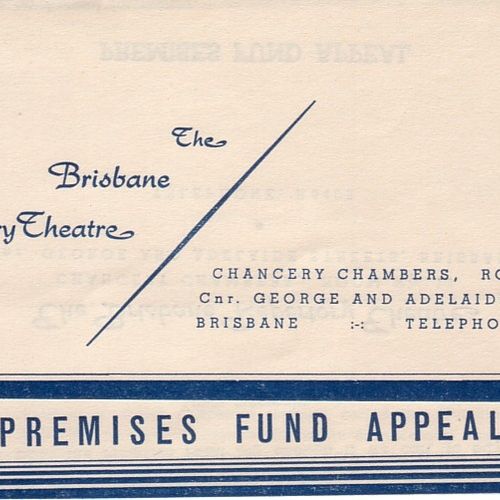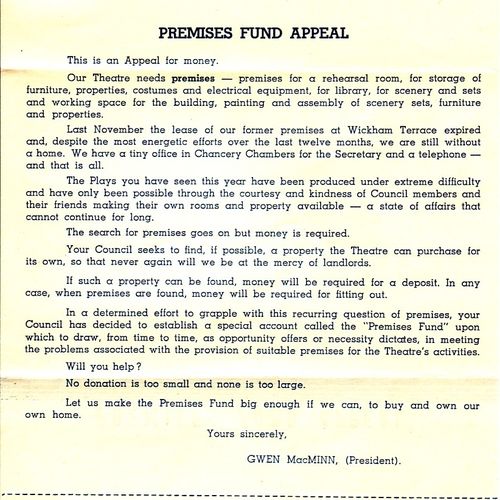The hunt begins for ‘a home of our own’
Australia-wide, amateur theatre companies enjoyed a resurgence of activity and popularity in the years immediately following World War Two. This occurred not only because life was returning to normal but also, for the first time in the nation’s history, support for the Arts was beginning to engage the interest of the Commonwealth Government. Linked to its postwar reconstruction aims was a growing understanding that strong support for cultural activities was a measure of a strong democracy.
Although direct funding of the Arts was still a long way off, the conversation had at least started. An early sign of a changing national perspective on cultural activities was the establishment of The Council for the Encouragement of Music and the Arts (CEMA) which toured cultural programs nationally from 1944 and whose objectives, mainly educative, were to bring the Arts to the people and encourage amateur groups. A year later it became the Arts Council of Australia and soon after had autonomous divisions in each State.
Renewed interest in theatre was also generated nationally by the high profile, hugely successful 1948 Australian tour by the Old Vic Theatre Company led by its stars Laurence Olivier and Vivien Leigh and which included visits to major amateur companies in every State.
In the immediate aftermath of the war, Brisbane Repertory’s focus was on its own ‘reconstruction’ forced upon it by the unexpected blow of losing both Sisley and Stable. For the next decade, a series of hard-working Presidents, Councils and directors kept activities flowing well, averaging six mainhouse seasons a year. Constitutional changes modernised the organisation: in 1946 ‘Society’ was dropped from the name and in 1951 an amendment dictated that a President’s term of office not exceed three years. Short bursts of energy by Presidents Tom Stephens (1946), Alex Foster (1947-1950), Cecil Carson (1951-1953) and Gwen MacMinn (1954-1956) and their respective Councils were more than enough to keep Repertory vital and holding its own.
As stability returned to Brisbane and interest was renewed in amateur theatre (as it was nationally), increasing membership became a priority for the Theatre’s ongoing financial sustainability. In a well-planned strategic operation, Alex Foster and his Council targeted the professional classes, sending out hundreds of letters, particularly to the city’s doctors and solicitors. The strategy worked – by the end of 1948 membership had increased to an extremely healthy 784.
Freed up from Sisley’s artistic dominance, long-time Council members Daphne Roemermann, Clare Clarke and Alex Foster emerged as major directors, able to give some sense of artistic continuity, at least until the early 1950s. Although artistic quality was uneven, audiences continued to enjoy the same variety in the repertoire that Sisley had insisted on – a blend of contemporary comedies and dramas with productions of classic plays by, for example, Shakespeare, Molière, Strindberg, Ibsen and Shaw. An innovation that Foster introduced was the improvement of design elements, previously a weak point in productions.
President Gwen MacMinn and her Council tackled head-on an issue that had long dogged Brisbane Repertory – suitable premises. From early in its history ‘a home of our own’ had been a much longed for goal. ‘Home’ for performances was still the Albert Hall which, by the early 1950s, was proving less and less satisfactory. In constant use since 1942 by the three leading amateur groups – Brisbane Repertory, Brisbane Arts Theatre and Twelfth Night Theatre – Albert Hall had its limitations in respect to the quality of its stage, dressing rooms and lighting equipment. An initial flurry of excitement in response to the Australia-wide debate about the possibility of a national theatre endowed by the Commonwealth Government led these three groups plus the Australian Theatre Guild, all keen for a home of their own, to consider seeking a government subsidy. Led by playwright and director Eunice Hanger from Twelfth Night Theatre, they reportedly gave serious consideration to applying for a subsidy for “the establishment of a permanent legitimate theatre for Brisbane”, perhaps a professional theatre company located at the Theatre Royal where all four groups “would be able to maintain a permanent succession of plays and musical comedies”.[i]
This excitement emanated from progressive English theatre director Tyrone Guthrie’s 1949 visit to Australia to advise the Federal Government on a national theatre – an invitation tendered amidst the euphoria still surrounding the hugely successful Old Vic tour. Over two weeks Guthrie met with theatre groups and saw performances in every capital city. He was not impressed, finding both standards of performance and audience appreciation to be low. In Brisbane, Guthrie made a presentation at Twelfth Night’s Club Rooms to the combined amateur companies during which he said that an actor with an Australian accent had “no opportunity of being placed in a major theatrical production in England”.[ii] Soon after, the debate and enthusiasm quickly faded.[iii] Guthrie made a number of recommendations to the Federal Government. If followed, a hand-picked group of Australian actors would be sent to England to train and make their debut in English productions, the only guarantee, he felt, of creating a national company with appropriate ‘standards’. The whole idea, which reeked to many of imperialism, ran out of steam after Guthrie’s report to Prime Minister Chifley was eventually rejected by the new Menzies government, effectively ending the plan for a national theatre and Brisbane Repertory’s opportunity for a permanent theatre space, albeit shared.
In due course, with no possibility of government support, MacMinn and her Council took matters into their own hands and launched a Premises Fund Appeal in 1956 through a brochure which unambiguously stated: “This is an Appeal for money. Our theatre needs premises … We have a tiny office in Chancery Chambers for the Secretary and a telephone – and that is all”.[iv] By the end of the year £300 had been raised by a hard working Social Committee, profits from the artistic program and donations from the 500-strong membership.[v] Not enough to buy the longed-for premises, £300 was nevertheless a solid start. It would be up to Gwen MacMinn’s successor to turn the vision for ‘a home of our own’ into a reality. Equally, the Theatre was in need of artistic re-invigoration. After Sisley’s death, no-one of her calibre and background had emerged to replace her, and the organisation was missing her artistic presence.
It was at this point in 1957 that Babette Stephens, a recognised ‘star’ of Brisbane theatre and radio, succeeded MacMinn as President. She was not new, by any means, to Repertory. In fact her involvement as an actress had begun as far back as 1930 and her experience on Committees, as an elected Council member in 1949 and as Vice- President the following year, prepared her well for this role and the subsequent position of Honorary Theatre Director. For the next ten years her formidable leadership style, compelling theatrical talent, dramatic personality and relentless energy were at the centre of all Brisbane Repertory’s activities and developments. Under her influence, and not without a certain amount of controversy, the theatre began once again to thrive artistically and ultimately to evolve as a theatrical organisation in a way she would not have imagined.
Writer: Christine Comans




Tell us your story